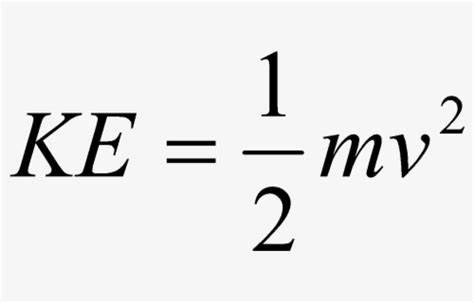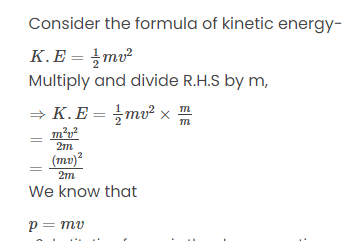
Linear Momentum Formula is the energy an object possesses due to its motion. It's one of the fundamental concepts in physics and is defined as the energy that an object has because of its velocity (speed) and mass. In other words, when an object is in motion, it has kinetic energy associated with that motion.
The formula for kinetic energy is: Where:
- KE represents the kinetic energy in joules (J).
- m is the mass of the object in kilograms (kg).
- v is the velocity (speed) of the object in meters per second (m/s).
Where:
- KE represents the kinetic energy in joules (J).
- m is the mass of the object in kilograms (kg).
- v is the velocity (speed) of the object in meters per second (m/s).
Key points about kinetic energy:
- Depends on Mass and Velocity: Kinetic energy is directly proportional to both the mass and the square of the velocity of the object. This means that increasing either the mass or the velocity will increase the kinetic energy.
- Scalar Quantity: Kinetic energy is a scalar quantity, meaning it only has magnitude (a numerical value) and no direction. It's always positive or zero and does not have a directional component.
- Conservation of Energy: According to the law of conservation of energy, the total mechanical energy (which includes both kinetic and potential energy) of an isolated system remains constant if there are no external forces acting on it. This principle is often used in various physical problems.
- Units: The SI unit of kinetic energy is the joule (J), which is equivalent to one kilogram-meter squared per second squared (1 kg·m^2/s^2).
Also Check - Kinetic Energy Formula
In practical terms, kinetic energy helps describe how fast an object is moving and how much "energy of motion" it possesses. For example, a speeding car has a significant amount of kinetic energy, and a slowly moving object has less kinetic energy. Understanding kinetic energy is essential in many areas of physics and engineering, particularly in the analysis of motion and collisions. Kinetic energy is a fundamental concept in physics that represents the energy an object possesses due to its motion. It's a measure of how much work an object could do because of its motion. In other words, it quantifies the energy associated with the movement of an object. Kinetic energy depends on two factors: - Mass (m): The mass of the object in kilograms (kg). This represents how much matter is in motion.Also Check - Unit, Dimension & Vector Formula
- Velocity (v): The velocity of the object in meters per second (m/s). This represents how fast the objectis moving.Linear Momentum (p):
Linear momentum, often denoted as "p," is another fundamental concept in physics that describes the quantity of motion of an object. It is a vector quantity, meaning it has both magnitude and direction. Linear momentum depends on two factors: - Mass (m): Just like in kinetic energy, it represents the mass of the object in kilograms (kg).Also Check - Work, Energy & Power Formula
- Velocity (v): This represents the velocity of the object in meters per second (m/s). However, unlike kinetic energy, linear momentum doesn't involve squaring the velocity. The formula for linear momentum is: p = m * v
Linear momentum is directly proportional to both the mass and the velocity of the object.
Now, let's define the relationship between kinetic energy and linear momentum:
The relationship between kinetic energy (KE) and linear momentum (p) can be expressed as follows:
KE = (1/2) * (p
2
/ m)
This equation shows that kinetic energy is directly related to the square of the magnitude of linear momentum (p) and inversely related to the mass (m) of the object. In essence, it tells us that as an object's linear momentum increases (either by increasing its velocity or mass), its kinetic energy also increases, but the relationship is quadratic, meaning that a small increase in momentum can result in a much larger increase in kinetic energy.
p = m * v
Linear momentum is directly proportional to both the mass and the velocity of the object.
Now, let's define the relationship between kinetic energy and linear momentum:
The relationship between kinetic energy (KE) and linear momentum (p) can be expressed as follows:
KE = (1/2) * (p
2
/ m)
This equation shows that kinetic energy is directly related to the square of the magnitude of linear momentum (p) and inversely related to the mass (m) of the object. In essence, it tells us that as an object's linear momentum increases (either by increasing its velocity or mass), its kinetic energy also increases, but the relationship is quadratic, meaning that a small increase in momentum can result in a much larger increase in kinetic energy.
Some Examples
Let's go through a couple of examples to illustrate the relationship between kinetic energy (KE), linear momentum (p), and how changes in mass or velocity affect them. Example 1: Car Moving on the Highway Imagine a car traveling on a highway with a mass of 1,000 kilograms (m) and a velocity of 30 meters per second (m/s).- Calculate the linear momentum (p):
- Calculate the kinetic energy (KE):
- Calculate the new linear momentum (p):
- Calculate the new kinetic energy (KE)
- Calculate the new linear momentum (p):
- Calculate the new kinetic energy (KE):
Linear Momentum Formula FAQs
What is kinetic energy, and how is it different from linear momentum?
Kinetic Energy (KE): Kinetic energy is the energy an object possesses due to its motion. It depends on both the mass and the square of the velocity of the object. KE is a scalar quantity and is measured in joules (J).
How are kinetic energy and linear momentum related mathematically?
The mathematical relationship between kinetic energy (KE) and linear momentum (p) is given by the formula: KE = (1/2) * (p^2 / m). This equation shows that kinetic energy is proportional to the square of the magnitude of linear momentum and inversely proportional to the mass of the object.
What happens to kinetic energy when an object's velocity doubles?
When an object's velocity doubles, its kinetic energy increases by a factor of four. This is because kinetic energy is directly proportional to the square of velocity. So, if the velocity is doubled, the kinetic energy will be four times greater.
What physical principles are associated with kinetic energy and linear momentum?
Conservation of Energy: The concept of kinetic energy is related to the conservation of mechanical energy, which states that the total mechanical energy (the sum of kinetic and potential energy) of an isolated system remains constant unless acted upon by external forces.
- Conservation of Linear Momentum: Linear momentum is associated with the conservation of linear momentum principle, which states that in the absence of external forces, the total linear momentum of an isolated system remains constant. This principle is often applied in the analysis of collisions and interactions between objects.
🔥 Trending Blogs
Talk to a counsellorHave doubts? Our support team will be happy to assist you!

Check out these Related Articles
Free Learning Resources
PW Books
Notes (Class 10-12)
PW Study Materials
Notes (Class 6-9)
Ncert Solutions
Govt Exams
Class 6th to 12th Online Courses
Govt Job Exams Courses
UPSC Coaching
Defence Exam Coaching
Gate Exam Coaching
Other Exams
Know about Physics Wallah
Physics Wallah is an Indian edtech platform that provides accessible & comprehensive learning experiences to students from Class 6th to postgraduate level. We also provide extensive NCERT solutions, sample paper, NEET, JEE Mains, BITSAT previous year papers & more such resources to students. Physics Wallah also caters to over 3.5 million registered students and over 78 lakh+ Youtube subscribers with 4.8 rating on its app.
We Stand Out because
We provide students with intensive courses with India’s qualified & experienced faculties & mentors. PW strives to make the learning experience comprehensive and accessible for students of all sections of society. We believe in empowering every single student who couldn't dream of a good career in engineering and medical field earlier.
Our Key Focus Areas
Physics Wallah's main focus is to make the learning experience as economical as possible for all students. With our affordable courses like Lakshya, Udaan and Arjuna and many others, we have been able to provide a platform for lakhs of aspirants. From providing Chemistry, Maths, Physics formula to giving e-books of eminent authors like RD Sharma, RS Aggarwal and Lakhmir Singh, PW focuses on every single student's need for preparation.
What Makes Us Different
Physics Wallah strives to develop a comprehensive pedagogical structure for students, where they get a state-of-the-art learning experience with study material and resources. Apart from catering students preparing for JEE Mains and NEET, PW also provides study material for each state board like Uttar Pradesh, Bihar, and others
Copyright © 2025 Physicswallah Limited All rights reserved.
Get App









